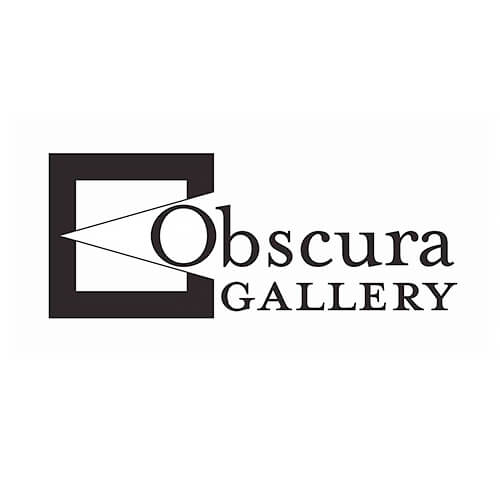Obscura Gallery and Brant Mackley Gallery present our jointly curated exhibition Home on the Range,an artistic exploration of cowboys in the American West from 19th-21st Century through photographs and objects. The exhibition will feature a selection of photographs from Obscura Gallery's contemporary photographers William Albert Allard and his legendary Vanishing Breedcowboy book, Kurt Markus's poignant After Barbered Wire cowboy photographs, Joan Myers' recently published 'Where the Buffalo Roamed' photographs of the 'new' West, and Manuello Paganelli's photographs of African American cowboys in the West. In addition, the exhibition will be accompanied by legendary 19th Century ranching photographer Laton Alton (LA) Huffman from Montana, as well as images from one of the first female ranching photographers, Elsa Spear Edwards Byron. Brant Mackley Gallery will be exhibiting a selection of Navajo saddle blankets and Northern Plains Indian beadwork from the late 19th through early 20th Century as well as other related material.
Obscura Gallery will be presenting photographs from as early as the 1880's which represent the first artistic photographs of ranching by LA Huffman. Huffman's most extensive and complete body of work relates to the cattle industry photographing the beginning, the heyday, and the end of the open range days in Montana as well as the changing Native American life and interaction during that time period.
From the same time period, we will have work by Elsa Spear Edwards Byron, who was born in 1896 into one of Wyoming's first ranching families, and had a career that spanned more than eighty years documenting a vanishing way of life with photographs of the lives of the Crow Indians, ranchers and the everyday life around her. Elsa was an eyewitness to the changes in the West as she worked on their family ranch in Montana and later as a mountain guide.
William Albert Allard, once from Minnesota and now based in Virginia is considered one of the most revered contemporary photographers on the subject of cowboys in the West. Allard's book Vanishing Breed published in 1982 was a monumental photographic tribute to the American cowboy and captures the hardships and loneliness of this vanishing way of life and revealed the spectacular natural beauty of the West. The book was nominated for The American Book Award and received the Leica Medal of Excellence.
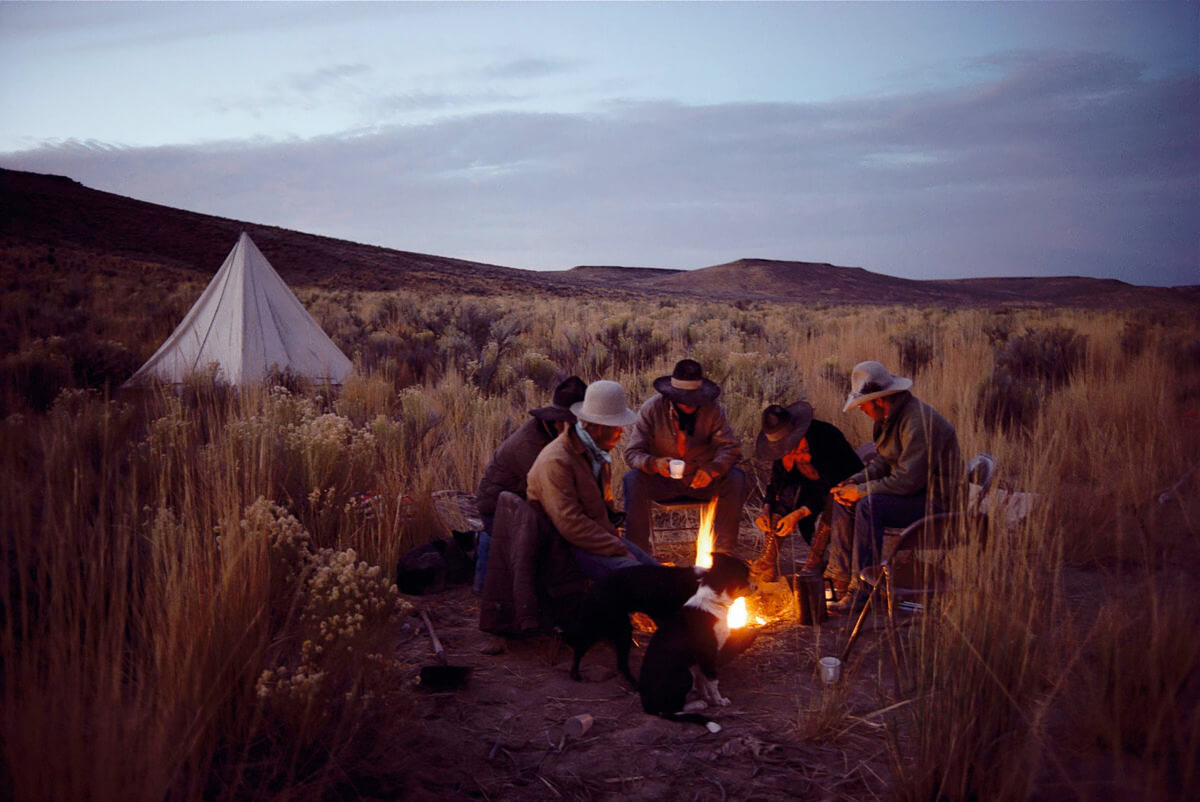
© William Albert Allard, IL cow camp at dawn, Nevada, 1979
William Albert Allard has been a major force at National Geographic and in mainstream photography for 50 years. He has contributed to National Geographic Society publications and books since 1964 as a staff member, a freelancer, and contracted photographer and writer. In addition, he was a former contributor to Magnum Photos and has been published in most major magazines in the United States and abroad. In October 2010, National Geographic Magazine recognized Allard's work on the American West with a 10-page excerpt from his book WILLIAM ALBERT ALLARD: Five Decades (Focal Point/National Geographic, 2010). Allard is one of the few photographers of his generation whose entire professional body of work is in color. National Geographic photographers esteem Allard to be the pioneer and peerless exemplar of natural, expressive color in documentary photography.
The son of a Swedish immigrant father, William Albert Allard was born in 1937 in Minneapolis, Minnesota. He studied at the Minneapolis School of Fine Arts and the University of Minnesota. Allard has received numerous awards for his work including the University of Minnesota Outstanding Achievement Award in 1994, The Joseph A. Sprague Memorial Award in 2002 and the University of Minnesota School of Journalism and Mass Communications Award for Excellence in 2004.
Allard has published six critically acclaimed books. His first book, Vanishing Breed (New York Graphic Society Books/Little Brown, 1981), was nominated for The American Book Award and received the Leica Medal of Excellence. Other books include The Photographic Essay (Bullfinch Press/Little Brown, 1989), A Time We Knew(University of Nevada Press, 1990), Time at the Lake: A Minnesota Album(Pfeifer/Hamilton Publishers, 1997), Portraits of America (Insight/National Geographic, 2001). His seventh book Eye of the Flaneur: Paris, a 31-year retrospective of his work in Paris is to be published by Edition Lammerhuber, Vienna, Austria in the fall of 2017. In 2019, Allard received the Figaro Magazine Lifetime Achievement Visa d'or Award at the Visa pour l'Image festival in Perpignan, France. His work is included in numerous permanent private and public collections including the Metropolitan Museum of Art, New York City and the Oklahoma Museum of Art.Allard lives near Charlottesville, Virginia with his wife and two dogs.
Kurt Markus, a Montana native, moved to New Mexico in 2014. Markus's personal work began with a focus on American West cowboys, which is perhaps his most acclaimed subject to this day, publishing After Barbed Wirein 1986, just four years after Allard's Vanishing Breed. After Barbed Wire's timeless photographs explore the rugged yet romantic spirit of the cowboy in beautifully printed black and white photogravures that many considered to be the truest depiction of life on the range since photographer L.A. Huffman published Before Barbed Wirein 1956 -both books portray the West in austere, workaday reality. Markus went on to publish Buckaroo and thenCowpuncher, which distilled more than 15 years of photographs of the Southwest cowboy into an enduring and timeless view of ranch life in Arizona, Texas, New Mexico, and Colorado.
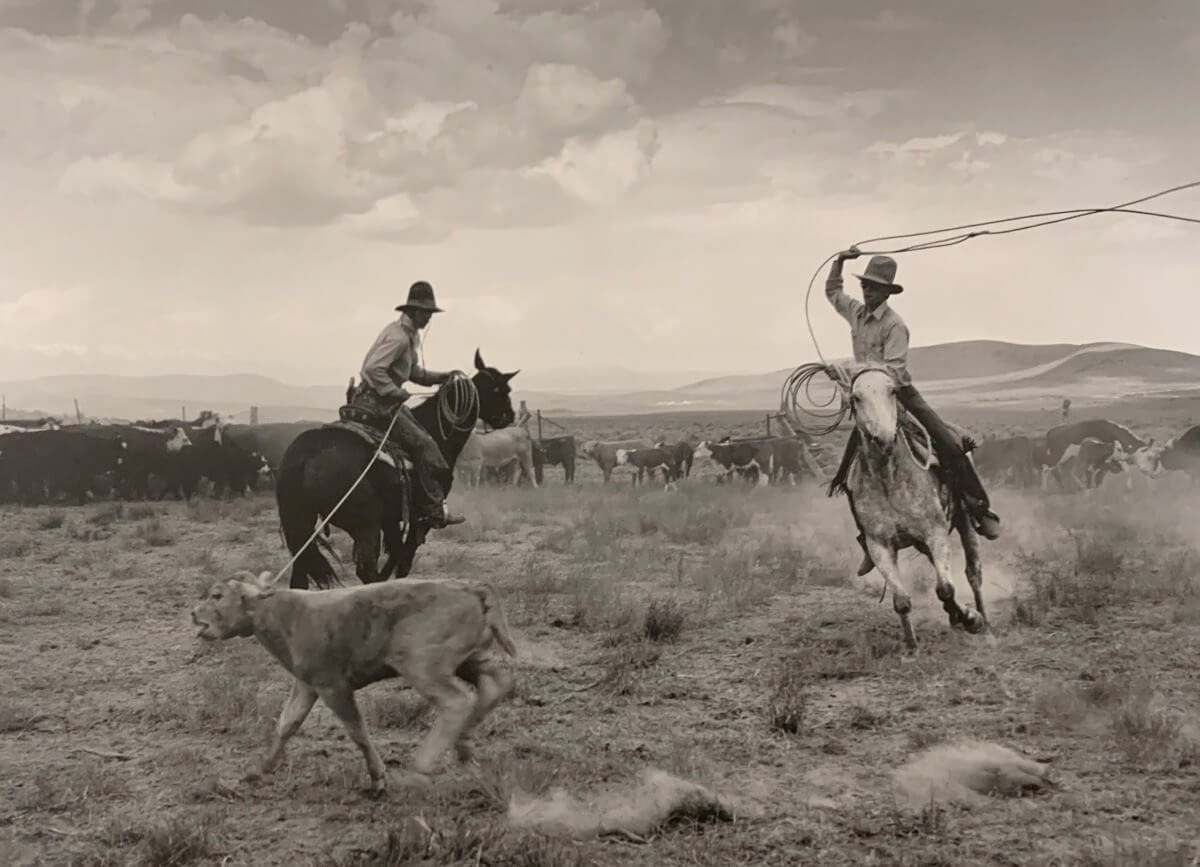
© Kurt Markus, White Horse Ranch, Fields, OR, 1984
In his book Buckaroo, Markus reflected on himself and his profession, saying this:
I was not born to ranching. I was born a daydreamer, and I know of no slot for one of those on any ranch. At times I am saddened that I am not what I photograph. Always the observer, seldom the participant, what I am made of remains unanswered. My distance protects me, physically and emotionally; from getting as busted up as I ought to sometimes. Which is why you're not going to get the whole truth from me. I have entered into an unspoken, unwritten and generally inscrutable pact with the people I have photographed and lived among: if I promise not to tell all I know about them, they will do the same for me. In most cases, I have more to hide. My consolation is a simple-heartedness I would not exchange. The greenest cowboy alive has my respect, and I have no problem whatsoever photographing people who are possessed with the determination to do what I cannot. The awful truth is that I love all of cowboying, even when everything has gone wrong and it's not looking to get any better. Sometimes I especially like it that way.
In addition to his three volumes of monographs on cowboys, Markus also published a book on boxers for which he traveled to New York, Dublin, Havana and Mexico City. In addition, under his own imprint, he published a book featuring the sand dune photographs of Brett and Edward Weston; as well as publishing a small volume in Japan, showcasing a fashion shoot in New Mexico in the spirit of Georgia O'Keeffe.
Markus has also directed and shot music videos for Jewel, Tori Amos, and John Mellencamp. He and son Ian completed the documentary film It's About You, made during Mellencamp's 2009 summer tour and recording sessions in blues legendary locations. An edited version opened for John on his 2010-2011 solo tour, and the full-length version premiered at the South by Southwest festival in 2011; it was also screened in Nashville and Dallas before opening theatrically in New York and Los Angeles, to positive reviews. In 2010, Kurt Markus wrote the screenplay Deep Six. It has gone on to win Los Angeles Cinema Awards' Merit Award and Los Angeles Movie Awards' Honorable Mention. He has since penned a second screenplay, Honor Code a narrative drama set against the backdrop of the My Lai, Vietnam, massacre.
For a contemporary approach on the American West and leaving the romanticism of the cowboy aside, Santa Fean
Joan Myers exhibits a selection of work from her newly published book, Where the Buffalo Roamed: Images of the New West (published by Damiani Editore in 2019). This compilation of photographs taken over the last forty-plus years focuses on the contemporary American West, turning our conception of western landscapes and the life contained within them upside down, revealing the changes this region has undergone over the last half-century. Her perspective is at once elegiac and ironic, capturing the myth and reality of the West, its shaping and appropriation by Hollywood, popular culture, and the ever-present, but fracturing American dream.
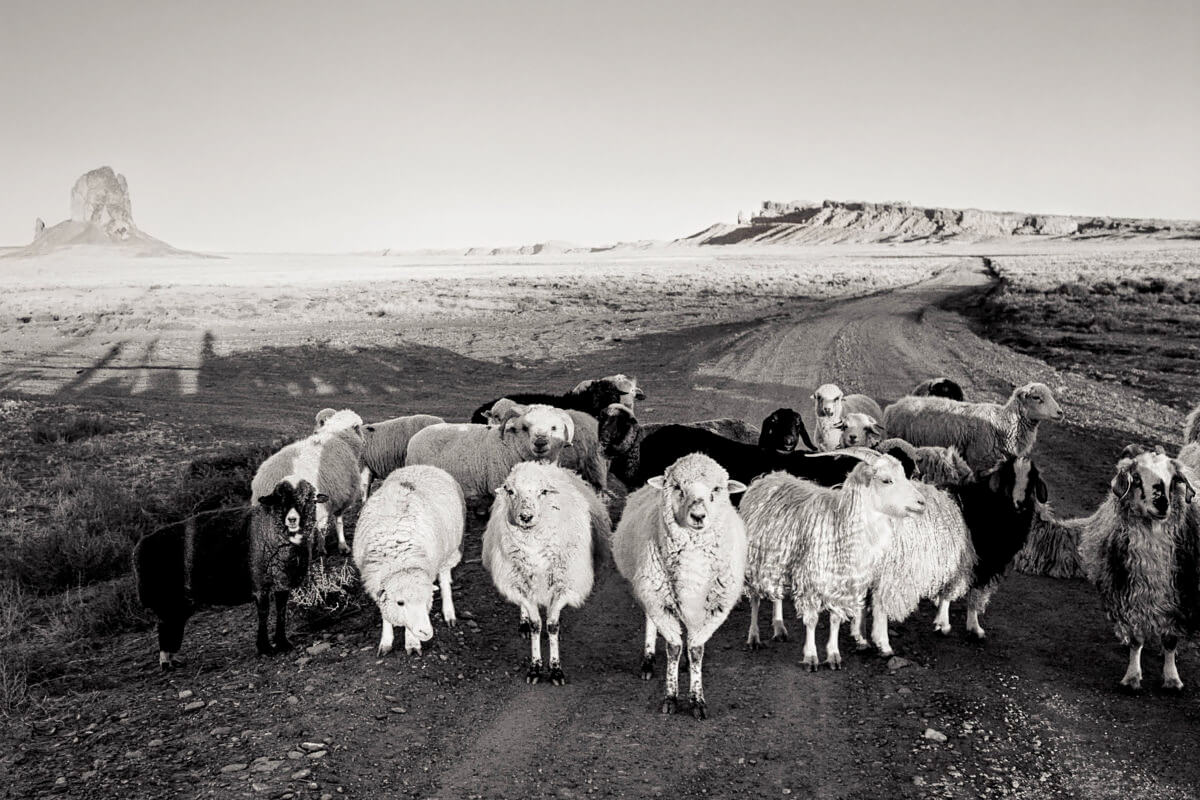
© Joan Myers, Monument Valley Sheep, UT, 1979
In deconstructing the pictures, cultural critic and Myers' book essayist Lucy Lippard says, Joan Myer's voyages around the changing West, from California to Oklahoma, from Montana to New Mexico, including the nations of Indian Country, have yielded images that seem to emerge from cracks in American culture. They show us a past that still affects, and reflects, our present, revealing unexpected insights into how the myths with which we were raised were formed and how they relate to reality.
She continues,In many of Myers' images there are American flags, even in Monument Valley on the Navajo Nation... Next to a jewelry shop in a ramada in a dusty red landscape is a flag shaped like a hearth (God Bless America).Many of the photographs include views of history that Myers has documented that are not local so much as it is Hollywood iconography reflected back into its birthplaces. In addition, Myers photographs iconic landscapes such as the Little Bighorn Battlefield in Montana, the infamous site of Custer's Last Stand in the 1876 battle between the 7thRegiment of the US Army and the combined forces of the Lakota, Sioux, Northern Cheyenne and Arapahoe Indians, as Lippard recognizes, now lost in high grasses, vast views, and historical amnesia, suggesting that the West can be seen as both a graveyard and a celebration of aspirations.
Lippard continues, Cowboys and Indians, western movie stars, rearing horses, tipis, and roaming buffalo are popular fare in murals, store window displays, water tanks, cafes, and service stations across the Western states –reminders of the (no longer) Wild (and often harsh, violent, and unfair) West.
Joan Myers has spent a lifetime learning and exploring. Born in Des Moines, Iowa in 1944, she attended Stanford University, where her concentration on Renaissance and baroque music performance led to a B.A in 1966 and a M.A. in musicology in 1967.In the early 1970's Myers turned to photography. She began as a large-format platinum-palladium printer, examining and photographing the relationships between people and the land. Her highly acclaimed work has been the focus of three Smithsonian exhibitions, more than fifty solo and eighty group shows, and eleven books. Her work is included in the permanent collections of the Amon Carter Museum, Bibliothèque Nationale de Paris, Center for Creative Photography, Denver Art Museum, George Eastman House, High Museum of Art, Minneapolis Museum of Art, Museum of Fine Arts, Houston, Museum of Modern Art, Nevada Museum of Art, and San Francisco Museum of Modern Art, among others
In 2002, the National Science Foundation awarded Myers an Antarctic Artists and Writer's Grant to photograph at McMurdo Station, surrounding field stations, historic huts, and the South Pole during the 2002-2003 austral summer. Her four-year traveling SITES show entitled Wondrous Cold: an Antarctic Journey opened at the National Museum of Natural History in Washington, DCin May 2006, accompanied by a book published by Smithsonian Books.In 2012, Myers' book The Jungle at the Door: A Glimpse of Wild India was published by George F. Thompson Books. A book entitled Fire and Ice: Timescapes, published by Damiani Editore in 2015, centers on volcanic and geothermal sites around the world. I've always been fascinated, she says, by what I cannot see and by what goes on beneath my feet.. A collaboration with poet Nathaniel Tarn, entitled The Persephones, was published in 2016
Manuello Paganelli will be showing a selection of portraits and images from the Black Cowboys series in which he photographed throughout the United States for the past several decades. Paganelli explains that the start of the project began
...during a flight In the early 1990s I sat next to an African American gentleman who participated in the Black Cowboys rodeo circuit and who educated me about the history and the great contribution ofBlack Cowboys in the wild West. Our extensive conversation was enlightening.My previous knowledge was based on Hollywood movies, not any historical materials, which omitted the participation of Black Cowboys. Intrigued, I was eagerto explore and examine the elements and regional influences, within this developed culture group, which has been unknown to most;yetaccording to Smithsonian magazine, in the late 1800's,1 out of 4 cowboys were Black. On my return back homeI called and pitched this incredible story to all my editorial clients. They didn't show any interest, except one called Emerge.The art director loved the idea, and he presented it to the managing editor and his reply was, when can he start on the BlackCowboys project? I started the journey to show my project to the world. This incredible documentary took me to rodeos, farms, ranches and family homes all across the US.
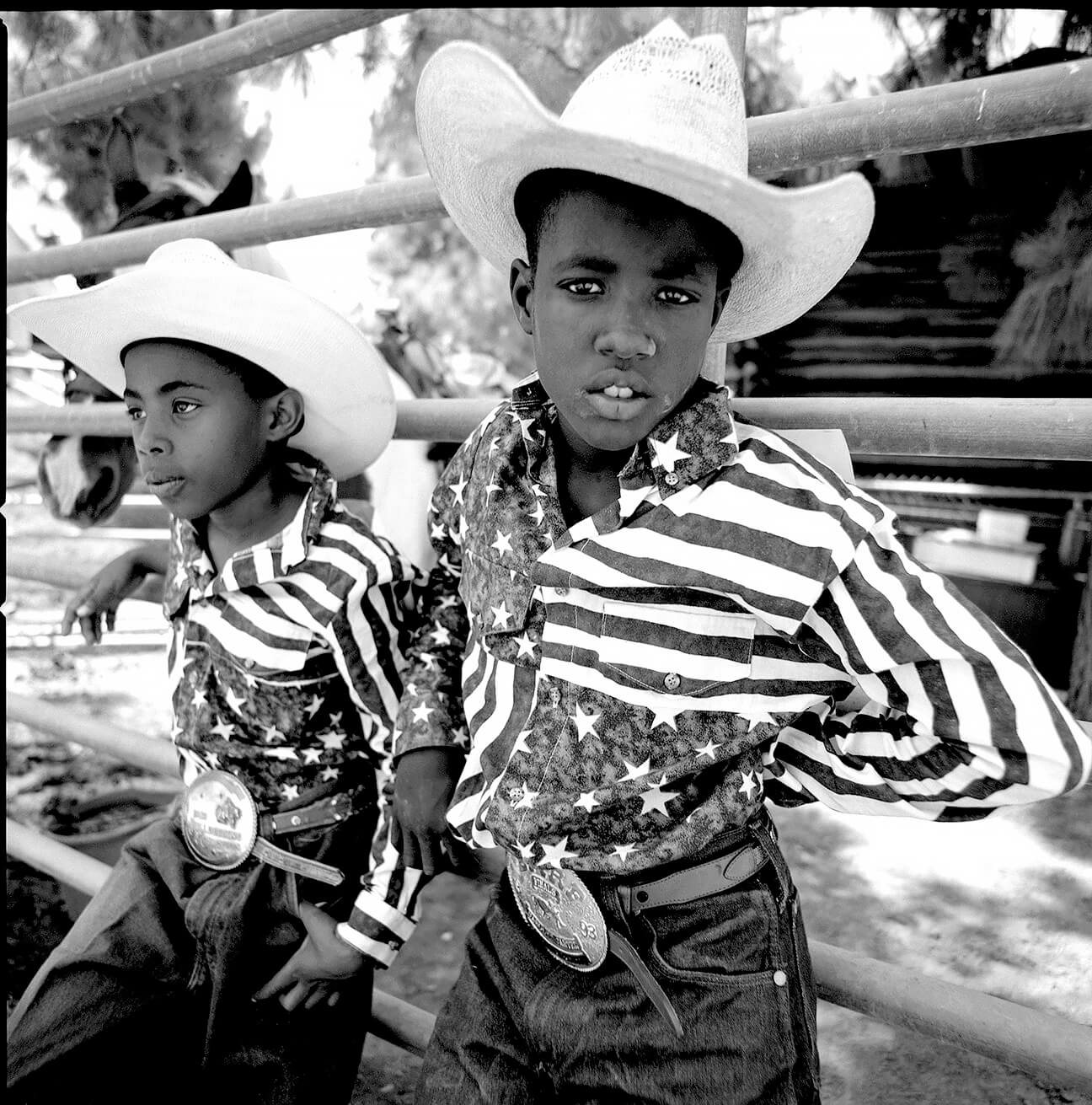
© Manuello Paganelli, Stars and Stripes, Los Angeles, CA, c. 1996
In the first half of the 1800's, white Americans who were seeking inexpensive landbegan moving to the Spanish (and, later, Mexican) territory of Texas. While the Mexican government opposed slavery, Americans brought slaves with them as they settled the land and established cotton farms and cattle ranches. By 1825, slaves accounted for nearly 25 percent of the Texas settler population and by 1860 (fifteen years after it became part of the Union), that number rose to over 30 percent. As an increasingly significant new slave state, Texas joined the Confederacy in 1861, andwhile the Civil War hardly reached Texas territory, many white Texans joined the fight with their Eastern brethren. While Texas ranchers fought in the war, they counted on their slaves to maintain their land and cattle herds, and because of this, the slaves developed the skills of cattle tending and ranching that would deem them invaluable to the industry in the post-war era.
This was a time before barbed wire therefore the lack of cattle containment and with few cowhands, the cattle population ran wild. When the ranchers returned from the War they found their herds were lost or running wild. Not long after their return, the Emancipation Proclamation left them without the slaveworkers on which they relied upon, and so the ranchers were then compelled to hire now freed,skilled AfricanAmericans as paid cowhands.
Once ranchers began selling their livestock tonorthern states where beef was nearly ten times more valuable than it was in cattle-inundated Texas, freed Blacksthat wereskilled in herding cattlefound that their workwas highly desirable. The railroad networks were still lacking andenormous herds of cattle needed to be physically moved to shipping points in Kansas, Colorado and Missouri. While AfricanAmerican cowboys faced discrimination in the towns they passed through(separated eating and sleeping quarters in restaurants and hotels for example),theyfound respect within their own crews and a level of equality unknown to other AfricanAmericans of the era.
Manuello Paganelli of Italian-Cuban descent, grew up in Santo Domingo, Italy and Puerto Rico. After a mentorship with Ansel Adams, he workedas a photojournalist at the Chattanooga Times. In 1989, he began to explore Cuba, its land, its people, and its complex relationship with the USA. In 1995, he had his first solo photo show of his work on Cuba and that same year earned him a fellowship grant. The Washington Post wrote Manuello Paganelli's Cuban photographs are a brilliant window on a land and people too long hidden from North American eyes. Working in the tradition of Cartier-Bresson and Robert Frank, Paganelli brings an artist's eyes and a native son's sensibility to his superb photographs.His award-winning work has graced the covers and pages of many well-known magazines including GQ, LIFE, Bloomberg Business Week, Forbes, Newsweek, Men's Journal, People, Time, Reader's Digest, ESPN, Sports Illustratedand many more.
In the early 1990s, after Paganelli started work on the Black Cowboy series, a selectionwas featured at the Annenberg Space for Photographyin and in the summer of 2012, this same series was chosen for the Photo Vernissage at the Manage Museum in St. Petersburg, Russia
